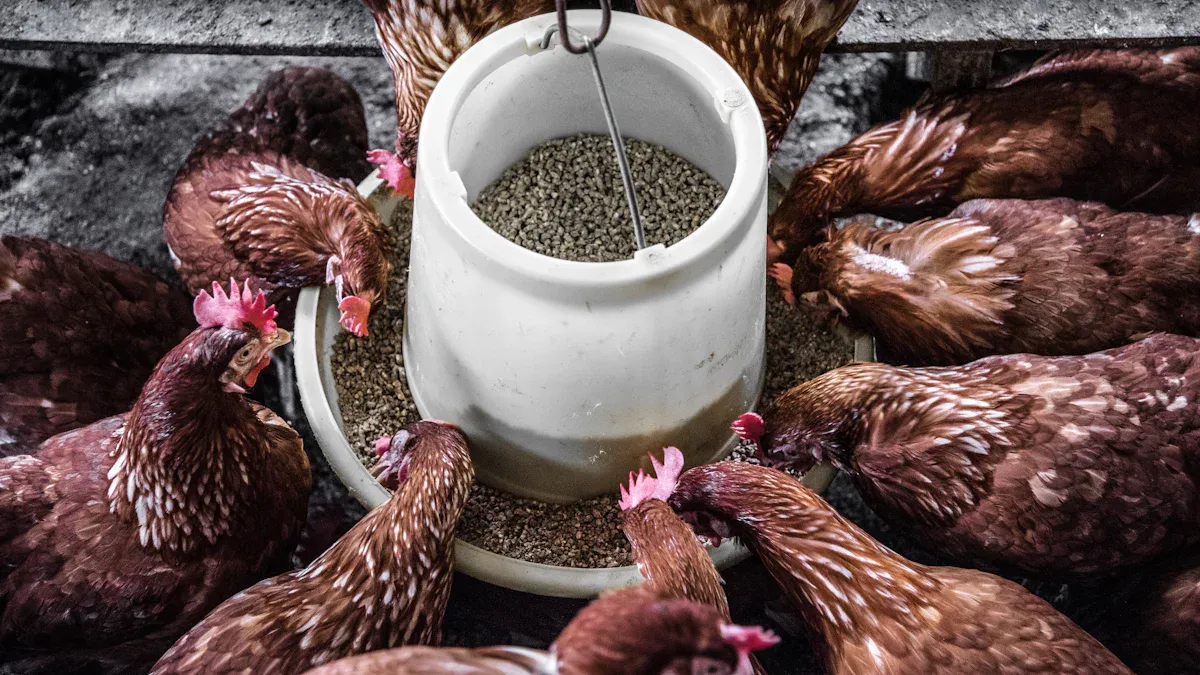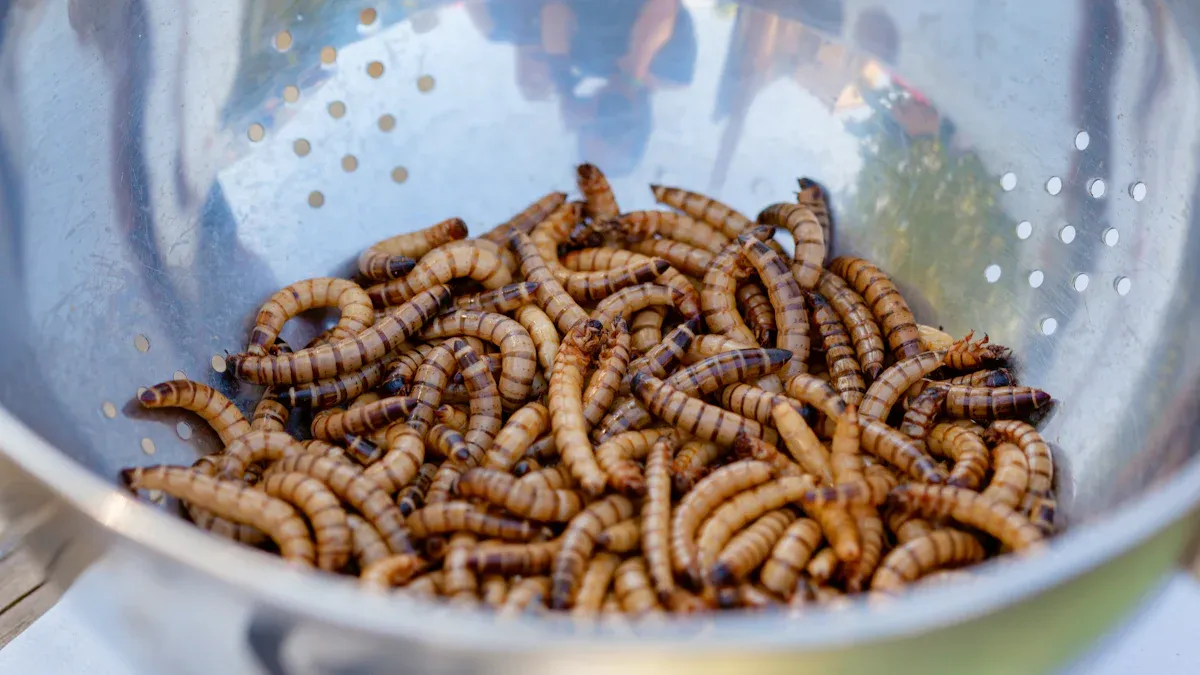
The Middle East faces a growing demand for sustainable animal feed solutions. This shift is driven by rising market trends:
- The pet feed market, valued at $955.8 million in 2022, is expected to hit $1.5 billion by 2031, growing at a 5.3% CAGR.
- Spending on premium protein products has surged by 27% in just three years.
Premium dried mealworms offer a game-changing solution. With 71% protein content and essential nutrients, they provide unmatched nutrition. Their farming requires minimal resources, making them an eco-friendly choice for animal feed mealworms.
Key Takeaways
- Dried mealworms are a high-protein, healthy option for animal feed. They help animals like chickens and cows grow well.
- Raising mealworms uses less water and land than raising animals. This makes them perfect for dry areas like the Middle East.
- The demand for mealworms is growing, giving farmers new ways to earn money. It also helps support farming that is better for the environment.
Nutritional Benefits of Animal Feed Mealworms
High Protein Content for Livestock and Poultry
Protein is essential for the growth and health of livestock and poultry. Mealworms stand out as a superior protein source compared to traditional feed ingredients. A comparison of protein content highlights their advantage:
| Source | Protein Content (g/100 g) | Total Essential Amino Acids (g/100 g) |
|---|---|---|
| Mealworms | 51.93 | 31.49 |
| Soybeans | 44.51 | 26.02 |
This high protein content makes mealworms an excellent choice for boosting animal growth and productivity. Farmers can rely on mealworms to meet the dietary needs of their livestock and poultry without compromising quality.
Rich Source of Essential Nutrients
Mealworms are packed with essential nutrients that animals need to thrive. They contain all the essential amino acids, making them a complete protein source. Studies show that mealworms can replace fish or soybean meal in animal diets without affecting growth performance. Additionally, their nutrient profile surpasses that of beef and chicken, offering a more efficient way to deliver vital nutrients.
Mealworms provide a sustainable and nutrient-rich alternative to conventional feed, ensuring animals receive the best possible nutrition.
Versatility Across Animal Species
One of the most remarkable features of mealworms is their versatility. They are suitable for a wide range of animals, including livestock, poultry, and even pets. Research confirms that mealworms can enhance digestibility and improve overall animal health when used as a substitute for traditional feed. Their adaptability makes them a valuable resource for farmers looking to optimize animal diets while promoting sustainability.
The growing demand for animal feed mealworms reflects their ability to meet the nutritional needs of diverse species. Whether for livestock or pets, mealworms offer a reliable and eco-friendly solution.
Sustainability of Mealworm Farming

Minimal Resource Requirements
Mealworm farming stands out for its efficiency. Unlike traditional livestock, mealworms require fewer resources to produce the same amount of protein. For example, the water footprint for mealworms is just 4341 m³ per ton, compared to a staggering 15,000 m³ for beef. They also use significantly less land, making them an ideal choice for regions with limited agricultural space.
| Metric | Mealworms | Traditional Livestock |
|---|---|---|
| Water Footprint (m³/t) | 4341 | 15000 (beef) |
| Land Use (m²/kg protein) | Less than livestock | More than mealworms |
| Greenhouse Gas Emissions | Significantly lower | Higher (CO2, N2O, CH4) |
| Feed Conversion Efficiency | Similar to poultry | Lower than mealworms |
This efficiency makes mealworms a sustainable option for animal feed mealworms, especially in arid regions like the Middle East.
Low Carbon Footprint Compared to Traditional Feed
Mealworm farming produces far fewer greenhouse gas emissions than conventional livestock farming. For instance, insects like mealworms emit only 2850 g of greenhouse gases per kilogram of mass gain. In comparison, pigs emit between 80–1130 g/kg, and beef cattle contribute significantly more.
| Parameter | Mealworms | Conventional Livestock |
|---|---|---|
| Greenhouse Gas Emissions | Significantly lower | Higher |
| Land Requirement (kg protein) | Less | More |
| Feed Conversion Efficiency | Comparable to poultry | Lower |
Additionally, mealworms have a water footprint comparable to chicken meat but are 3.5 times more efficient than beef. This low environmental impact makes them a game-changer for sustainable agriculture.
Contribution to Sustainable Agriculture in the Middle East
The Middle East faces unique challenges in agriculture, including water scarcity and limited arable land. Mealworm farming offers a practical solution. By requiring fewer resources and producing fewer emissions, mealworms align perfectly with the region’s sustainability goals. Farmers can adopt mealworm farming to reduce their environmental footprint while meeting the rising demand for alternative protein sources.
Animal feed mealworms not only support sustainable practices but also create economic opportunities. They allow farmers to diversify their income streams and contribute to a more resilient agricultural sector. This innovation could transform the Middle East’s approach to animal feed, paving the way for a greener future.
Market Potential for Animal Feed Mealworms in the Middle East
Alignment with Regional Sustainability Goals
The Middle East is actively pursuing sustainability in agriculture. Mealworms align perfectly with these goals by offering a low-impact alternative to traditional feed. Their farming requires less water and land, which is critical for arid regions. For example, mealworms use significantly less water than beef production, making them ideal for areas facing water scarcity.
Governments in the region are also supporting insect-based industries. This push for sustainable protein sources reflects the growing awareness of environmental challenges. A comparison of sustainability initiatives across regions highlights the Middle East’s focus on food security:
| Region | Acceptance Level | Sustainability Initiatives |
|---|---|---|
| Middle East | Varied | Food security efforts |
| South Africa | Increasing | Insect farming investment |
| Asia Pacific | Established | Traditional consumption |
Mealworms’ ability to reduce greenhouse gas emissions and their efficient resource use make them a key player in achieving these goals.
Economic Opportunities for Farmers and Producers
Mealworm farming opens new doors for farmers and producers in the Middle East. It offers a profitable and sustainable business model. The market for mealworms is projected to grow at a compound annual growth rate (CAGR) of 25.8%, reaching $1.27 billion by 2030. This growth creates opportunities for farmers to diversify their income streams.
Small-scale farmers, in particular, can benefit from mealworm farming. It requires minimal investment and offers high returns. Additionally, mealworms’ high nutritional value and environmental benefits make them an attractive option for producers looking to meet the rising demand for sustainable feed.
Rising Demand for Alternative Protein Sources
The Middle East’s population is growing at an annual rate of 1.4%, with a projected population of 580 million by 2030. This growth drives the need for alternative protein sources like mealworms. In Saudi Arabia and the UAE, protein consumption is expected to increase by 35-40% within the next decade.
| Statistic Description | Value |
|---|---|
| Annual population growth rate in the Middle East | 1.4% |
| Projected population by 2030 | 580 million |
| Increase in protein consumption in Saudi Arabia and UAE | 35-40% within the next decade |
| Average per capita meat consumption in the region | 85 kg annually |
| Global average per capita meat consumption | 43 kg annually |
Mealworms provide a sustainable solution to meet this demand. Their versatility and high nutritional value make them a reliable choice for animal feed mealworms, ensuring the region’s growing protein needs are met without compromising the environment.
Premium dried mealworms offer a triple advantage: superior nutrition, environmental sustainability, and economic potential. They provide high protein, essential nutrients, and versatility for various animals. Their farming uses fewer resources, emits less greenhouse gas, and supports sustainable waste management by utilizing organic waste.
- Cost-effective and eco-friendly compared to soy-based feed.
- Lower ammonia and greenhouse gas emissions.
- Aligns with circular economy principles.
Adopting mealworm-based feed can revolutionize animal agriculture. It’s time to embrace this innovative solution for a sustainable future. 🌱
FAQ
What makes mealworms a better choice for animal feed?
Mealworms provide high protein, essential nutrients, and sustainability. They require fewer resources and produce less waste compared to traditional feed options.
Can mealworms be used for all types of animals?
Yes, mealworms are versatile. They work well for livestock, poultry, and even pets, offering a nutritious and eco-friendly feed alternative.
How does mealworm farming benefit the environment?
Mealworm farming uses less water, land, and energy. It also reduces greenhouse gas emissions, making it a sustainable solution for animal feed mealworms.


